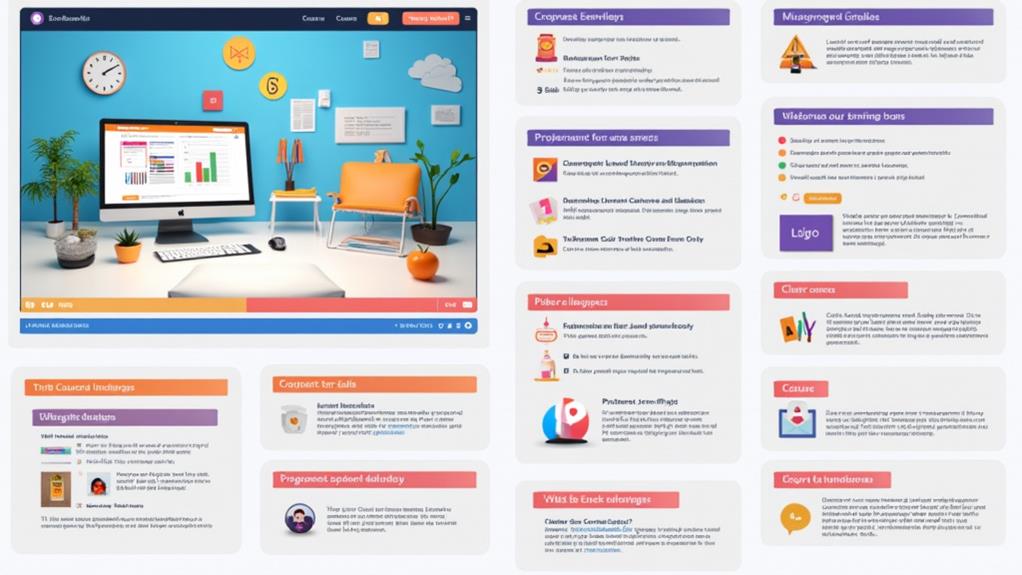
To maximize engagement in an online course, start by deeply understanding your audience through demographic analysis and feedback sessions. Conduct thorough market research and validate your course ideas to target in-demand subjects. Design a structured, modular course with varied content formats like videos, quizzes, and interactive elements to cater to different learning styles. Clearly define learning objectives and communicate these at the beginning of each module. Foster interaction through discussion forums and collaborative projects, and utilize analytics to monitor progress. Continuously refine the content and structure based on learner feedback to maintain high engagement. There are more strategies and details to explore.
Key Takeaways
- Understand Your Audience: Tailor content based on comprehensive demographic and learning needs analysis to boost relevance and engagement.
- Utilize Varied Content Formats: Incorporate videos, quizzes, and interactive elements to cater to different learning styles and maintain interest.
- Implement Feedback Mechanisms: Use pre-launch surveys and social media feedback to validate course ideas and address market gaps.
- Design Modular Course Structure: Break down courses into manageable modules with a logical sequence to facilitate systematic learning.
- Foster Interactive Learning: Introduce gamification, real-time feedback, and collaborative projects to enhance student participation and retention.
Understand Your Audience
Understanding your audience is paramount to designing an effective online course, as it guarantees that the content is both relevant and engaging. Conducting a thorough demographic analysis is the first step in this process. This involves identifying the age, educational background, and professional experiences of your learners. Such data-driven insights allow for crafting content that resonates with the target audience's specific needs and preferences.
Leveraging digital marketing and SEO can also help in reaching a broader audience and understanding regional dynamics.
Surveys and feedback sessions are invaluable tools in this endeavor. They reveal the particular learning needs and styles of your audience, enhancing learner engagement by affirming that the course material is both meaningful and accessible. Additionally, understanding common challenges faced by your learners can help in designing course elements that address these issues directly.
Creating learner personas based on this demographic analysis further fine-tunes your course design. These personas serve as hypothetical archetypes that encapsulate the key characteristics of your target audience, guiding the development of relevant and relatable content.
Regularly revisiting and updating these audience insights guarantees that the course remains aligned with the evolving needs and interests of your learners, thereby maintaining high levels of engagement and educational effectiveness throughout the course duration.
Identify Course Topics
Identifying course topics begins with conducting thorough market research to spot in-demand subjects like Digital Marketing, Finance, and Fitness, which consistently attract learners.
Evaluating audience needs through pre-launch surveys can validate your course ideas, ensuring there is sufficient market interest to avoid low enrollment rates.
Additionally, leveraging your expertise and analyzing content consumption patterns will help align your course with current trends and learner challenges, creating a more engaging and relevant educational experience.
Understanding competitors' offerings can also provide insights into topics that resonate with learners, helping you refine your course structure for maximum appeal.
Conduct Market Research
Conducting market research is a pivotal step in identifying high-demand course topics that guarantee learner engagement and success. By leveraging trend analysis and audience segmentation, course creators can pinpoint subjects that resonate with their target demographic. Utilizing tools like Google Trends allows for real-time insight into rising topics and search interest, guaranteeing course offerings align with current demands.
In addition to trend analysis, gathering data through surveys and feedback from your target audience can validate potential course ideas. This approach guarantees that the content not only attracts but also addresses the specific needs and pain points of learners. Additionally, competitor analysis on platforms like Udemy and Coursera can reveal market gaps, offering opportunities to provide unique or improved content.
The following table illustrates essential tools and strategies for effective market research:
| Research Tool | Purpose |
|---|---|
| Google Trends | Identify rising topics and search interest |
| Surveys & Feedback | Validate course ideas and learner needs |
| Competitor Analysis | Discover market gaps and opportunities |
Assess Audience Needs
To create an impactful online course, it is essential to meticulously assess the needs of your target audience, guaranteeing that the content is both relevant and valuable. This process involves understanding who your learners are and what they require to achieve their educational goals.
By focusing on audience segmentation and developing detailed learner personas, you can tailor your course to meet specific needs effectively.
Here are four steps to assess audience needs:
- Conduct Market Research: Identify trending topics and gaps in existing courses. Focus on high-demand areas such as Digital Marketing, Finance, and Fitness, as highlighted by recent surveys.
- Pre-Launch Surveys and Feedback: Utilize tools like pre-launch surveys to gather direct insights from potential learners. This helps validate course ideas and guarantees that the topics align with their interests and needs.
- Analyze Audience Demographics and Learning Styles: Study the demographics and preferred learning styles of your audience. Tailoring content and delivery methods to match these factors increases engagement and relevance by addressing specific learner challenges.
- Implement Audience Analysis Tools: Use tools to gather data on educational backgrounds and professional experiences. This allows for creating highly personalized and effective course structures.
Incorporating these strategies guarantees your course remains learner-centered, data-driven, and outcome-focused, ultimately enhancing engagement and educational impact.
Validate Course Ideas
Validating course ideas is a critical step in the development of an online course, guaranteeing that the content you create resonates deeply with your target audience. Conducting thorough market research to identify trending topics in fields like Digital Marketing, Finance, and Fitness can align your course with current demand. This data-driven approach helps in the initial idea refinement, setting a strong foundation for course success.
Utilizing pre-launch surveys allows you to gather course feedback directly from potential students. This feedback is invaluable in understanding their interests and needs, enabling you to tailor your course content accordingly.
Moreover, analyzing existing courses in your niche helps identify gaps in content or delivery, providing an opportunity to offer unique value that can attract more learners.
Social media platforms and online forums are rich sources of information, where discussions and questions from your target audience can guide the selection of relevant course topics.
Additionally, establishing clear learning objectives based on validated course ideas guarantees that your content meets the expectations and requirements of potential students. By focusing on these strategies, you can create a structured, engaging online course that maximizes learner outcomes.
Conduct Market Research

Conducting market research is vital to understanding audience needs, analyzing competitor offerings, and validating course demand.
Utilizing tools like Google Trends and keyword research can provide valuable insights into what learners are actively seeking. Additionally, competitor analysis and pre-launch surveys can help refine your course content to guarantee it meets market demands effectively.
Examining the target demographics and their preferences can further tailor your course to resonate more deeply with potential students.
Identify Audience Needs
Understanding your audience's needs is paramount to creating an online course that truly resonates and delivers value. Conducting thorough market research is essential to pinpoint the specific knowledge gaps and interests of your target audience.
By leveraging feedback mechanisms such as surveys and interviews, you can gain insights into learners' preferred learning preferences, existing skills, and desired outcomes. This data-driven approach guarantees that your course content remains relevant and engaging.
In your market research, consider the following steps:
- Demographic Analysis: Identify the age, gender, occupation, and other relevant characteristics of your target audience to tailor content that appeals to them.
- Skill Assessments: Understand the current skill levels and knowledge gaps within your audience to design modules that are appropriately challenging and beneficial.
- Feedback Mechanisms: Utilize surveys and interviews to gather information on learning preferences and specific interests, enabling you to adapt your course to meet these needs.
- Engagement Strategies: Analyze data to develop strategies that keep learners engaged, such as interactive elements and practical applications.
Analyze Competitor Offerings
After identifying the needs of your target audience, the next step is to conduct a detailed analysis of your competitors' offerings to guarantee your course stands out in the market.
Begin with a competitor comparison to identify popular course topics. Utilize tools like Google Trends and keyword research to pinpoint content gaps that competitors may be overlooking. This data-driven approach guarantees your course addresses unmet needs and captures market interest.
Examine pricing strategies of similar courses to establish a competitive yet profitable price point for your offering. Review various course formats on platforms such as Udemy and Coursera to determine which structures—be it video lectures, interactive quizzes, or multimedia elements—resonate most with learners.
Dive into student reviews to extract insights on what learners appreciate and what they find lacking in existing courses. This feedback will guide your engagement techniques and help improve your course's completion rates.
Analyze competitors' marketing tactics, including social media usage, email campaigns, and SEO practices, to understand effective outreach methods. By incorporating these strategies, you can enhance visibility and attract more students.
Ultimately, this extensive market research guarantees your course is well-positioned to achieve maximum engagement and successful learning outcomes.
Validate Course Demand
To guarantee your online course meets market demand, it is essential to validate your course idea through extensive market research. Conducting a thorough validation process guarantees you are creating a course that resonates with your target audience and addresses their specific needs.
1. Survey Methods:
Conduct surveys targeting your potential audience to gauge interest in specific topics. Aim for a response rate of at least 10% to guarantee reliable data. This feedback will provide invaluable insights into what learners are looking for.
2. Trend Analysis:
Utilize tools like Google Trends to identify rising topics within your niche. This allows you to align your course content with current market demand, guaranteeing it remains relevant and appealing.
3. Competitor Insights:
Analyze competitors by reviewing their course offerings and student feedback on platforms like Udemy or Coursera. This helps identify gaps in the market that your course can fill, making it more competitive and unique.
4. Keyword Strategies:
Use keyword research tools such as SEMrush or Ahrefs to find popular search terms related to your topic. High search volumes indicate strong market interest and demand for content in that area.
Define Learning Objectives
Defining learning objectives is an essential step in structuring an online course as it sets the foundation for measurable outcomes that align content and assessments with student expectations. Clearly articulated learning objectives guide course design by establishing specific, measurable, achievable, relevant, and time-bound (SMART) goals. This structured approach enhances clarity for both instructors and learners, fostering focused engagement throughout the course.
Incorporating Bloom's Taxonomy when crafting learning objectives guarantees that the course promotes higher-order thinking, facilitating a deeper understanding of the material. Communicating these objectives at the beginning of each module helps set clear expectations and motivates students by highlighting the skills and knowledge they will acquire.
Regularly revisiting and refining learning objectives based on student feedback and assessment outcomes can greatly improve course relevance and overall learner satisfaction. By aligning content and assessments with these objectives, instructors can create a cohesive and impactful learning experience.
| Aspect | Description | Impact |
|---|---|---|
| Measurable Outcomes | Clear, quantifiable goals | Enhances assessment accuracy |
| Structured Approach | Use of Bloom's Taxonomy for objective crafting | Encourages higher-order thinking |
| Course Relevance | Regular updates based on feedback | Improves learner engagement |
| Student Feedback | Continuous refinement of objectives | Aligns with student needs |
This table encapsulates the key aspects and their impacts, facilitating a thorough understanding of effective learning objective definition.
Design Course Structure

Establishing clear learning objectives forms the foundation upon which the course structure is built. A well-structured online course outlines these objectives for each module, guiding both content development and student expectations. This clarity enhances engagement and focus, allowing learners to understand the purpose and expected outcomes of their study.
Personalized learning paths can further improve this by catering to unique student needs and enhancing academic performance. Additionally, incorporating diverse methodologies and interactive multimedia tools can greatly boost student engagement and retention.
Key elements to design an effective course structure include:
- Modular Breakdown: Dividing the course into manageable modules or sections helps learners digest information systematically, reducing cognitive overload and improving retention rates. Each module should have specific, measurable learning objectives that align with the overall course goals.
- Logical Sequence: Implementing a logical sequence of topics allows that each lesson builds on previously acquired knowledge. This fosters a seamless course flow, enabling a deeper understanding and a more cohesive learning experience.
- Varied Content Formats: Utilizing varied content formats, such as videos, quizzes, and interactive elements, caters to different learning styles and keeps students actively engaged. This diversity in content presentation enhances learner interaction and retention.
- Consistent Organization: Consistent organization and easy navigation within the course platform enhance user experience. Clear module pacing and a predictable structure encourage regular participation and interaction among learners.
Create Engaging Content
Creating engaging content is vital for capturing and maintaining the interest of online learners. To achieve this, utilizing a variety of content formats such as videos, quizzes, and interactive elements is essential. These multimedia formats cater to different learning styles and help retain student interest throughout the course.
Storytelling techniques and real-world examples can make abstract concepts more relatable and enhance understanding, providing a more immersive learning experience. Additionally, leveraging client testimonials can build trust and credibility in the educational content.
Regularly updating course content guarantees its relevance and keeps learners engaged with the most current information. This practice not only sustains interest but also improves overall learning outcomes.
Creating engaging discussion prompts and forums encourages active participation and peer interaction, fostering a sense of community among students and enhancing collaborative learning.
Implementing gamification strategies, such as point systems and badges for completed activities, can greatly motivate learners. These strategies not only make learning more enjoyable but also allow for the tracking of progress through engagement metrics, providing valuable insights into learner achievements and areas needing improvement.
Incorporate Multimedia Elements

Incorporating multimedia elements such as videos, infographics, and interactive quizzes can greatly enhance the visual appeal of your online course, catering to various learning styles and increasing engagement by up to 80%.
Data-driven strategies show that interactive content like polls and discussion prompts boost participation rates by 60%, making your course more dynamic and learner-centered.
Tools like Padlet support collaborative learning environments, further enriching the interactive experience for students.
Enhance Visual Appeal
Although the content is paramount, enhancing the visual appeal of your online course can greatly boost learner engagement and retention. Integrating visual storytelling and professional graphic design can make complex concepts more accessible and enjoyable.
Studies indicate that incorporating multimedia elements like videos, infographics, and interactive quizzes can increase learner engagement by up to 60%, effectively supporting diverse learning styles and improving retention rates.
Consider the following strategies to enhance visual appeal:
- Incorporate High-Quality Visuals: Use relevant images and graphics to support textual information. Research shows that learners retain 65% of information when paired with visuals, compared to just 10% with text alone.
- Utilize Video Content: Creating engaging video content can greatly enhance understanding. Videos cater to visual and auditory learners, making the material more dynamic and easier to comprehend.
- Design Interactive Graphics: Clickable graphics and gamified content can boost completion rates by 50%, encouraging active participation and deeper learning experiences.
- Regularly Update Multimedia Elements: Keeping your multimedia content current with the latest technology trends increases learner satisfaction and engagement, with 70% of learners preferring courses that incorporate up-to-date content.
Boost Interactive Learning**
To significantly enhance student engagement and retention, leveraging multimedia elements is vital in the design of online courses. Incorporating multimedia presentations, such as videos, infographics, and interactive quizzes, can markedly boost retention rates, with studies indicating that learners retain 60% of information presented through video compared to just 10% through text alone.
Utilizing gamification techniques and interactive elements like polls can foster a sense of collaboration and competition, leading to a remarkable 30% increase in course completion rates.
Real-time feedback during multimedia presentations is also essential, as 78% of students report higher engagement when they receive immediate responses to their input. This method not only motivates learners but also guarantees they are actively participating in the learning process.
Integrating diverse formats, such as audio podcasts and live webinars, caters to various learning styles, making content more relatable for 65% of learners.
Regular updates and the inclusion of current, multimedia-rich content keep courses relevant and engaging, with 80% of students preferring courses that utilize up-to-date resources.
Choose a Hosting Platform
Selecting a reliable hosting platform is a foundational step in ensuring seamless course delivery and maximizing learner engagement. Key considerations include evaluating hosting platform features and platform integration options to provide a robust learning experience.
1. Assess Hosting Platform Features: Platforms like Teyuto and Sensei LMS offer extensive features tailored for effective online education management. These include course creation tools, multimedia support, and user management systems.
A robust platform can also enhance brand awareness and community engagement through consistent updates and interactive features.
2. Evaluate Platform Integration Options: Integration with analytics tools is essential for tracking student engagement and performance. This data-driven approach allows instructors to make informed decisions for course improvements.
Leveraging data analysis tools like Google Analytics can provide deeper insights into learner behavior and trends.
3. Consider Self-Hosted vs. Cloud-Based Solutions: Self-hosted platforms offer complete control over data and customization, ideal for those needing specific functionalities and security.
Conversely, cloud-based LMS solutions provide ease of use and accessibility, beneficial for both instructors and students.
4. Explore Course Marketplaces: Platforms such as Udemy and Coursera can greatly expand your audience reach by leveraging their established user bases.
This can attract a broader range of potential learners to your course.
Implement Assessment Strategies

Why are assessment strategies crucial for the success of an online course? Implementing diverse and robust assessment strategies is critical to fostering student engagement, knowledge retention, and critical thinking. By incorporating formative assessments like weekly quizzes, instructors can provide ongoing feedback and gauge student understanding before progressing to more complex concepts. This ongoing evaluation is essential for guaranteeing that learning objectives are met effectively.
Additionally, incorporating multimedia elements such as videos and interactive activities in assessments can enhance engagement and relatability.
To cater to different learning styles and measure a wide range of skills, a variety of assessment methods—quizzes, assignments, and projects—should be utilized. These methods should align with clearly defined learning objectives, ensuring that students are aware of the skills they need to demonstrate upon course completion.
Additionally, incorporating peer feedback and self-reflection exercises can foster community building and encourage students to engage critically with their own and others' work.
Technology integration and performance analytics enable instructors to track student performance and engagement meticulously. This data-driven approach facilitates timely interventions, ensuring continuous improvement of instructional strategies.
Effective assessment alignment guarantees that each assessment is purposeful and directly linked to desired learning outcomes, thereby maximizing student engagement and mastering course content.
Foster Student Interaction
Building on the importance of effective assessment strategies, fostering student interaction is another pivotal element in structuring an engaging online course. Effective interaction strategies can considerably enhance student experiences, making the learning process more dynamic and collaborative.
According to research, consistent engagement strategies can maintain student interest and participation, much like the regular posting strategies used in social media marketing.
Here are four key engagement techniques to foster student interaction:
- Discussion Forums: Create spaces for students to share their thoughts and course reflections. This fosters community building and has been shown to increase engagement levels by 50%.
- Collaborative Projects: Encourage peer collaboration through group work. Collaborative projects not only aid in understanding and retention but also address learning challenges more effectively, boosting retention by up to 60%.
- Interactive Elements: Incorporate polls and quizzes during live sessions. Such elements maintain attention and participation, leading to a 30% increase in student satisfaction ratings.
- Icebreaker Activities: Implement icebreaker discussions at the course outset. Establishing early connections among participants can lead to stronger peer relationships and higher course completion rates.
Regular feedback sharing through surveys allows for adaptive course content, improving engagement and responsiveness, and increasing perceived course value by 40%.
Monitor Student Progress

Monitoring student progress is vital for guaranteeing that learners achieve the desired outcomes in an online course. Utilizing analytics tools embedded in learning management systems (LMS) allows educators to track student engagement metrics such as log-ins, assignment submissions, and forum participation.
These insights are significant for evaluating overall course effectiveness and identifying areas where students may need additional support. Consistent testing of content helps identify which course modules resonate most with learners, providing an opportunity to refine strategies and enhance engagement.
Additionally, creating a content calendar can help maintain regular assessment schedules and guarantee that feedback is timely.
Regular progress tracking through weekly assessments or quizzes helps gauge students' understanding and retention of the material. This data-driven approach enables timely intervention if students are struggling, thereby enhancing learning outcomes.
Encouraging self-assessment by providing rubrics or evaluation tools empowers students to take ownership of their learning journey and align their efforts with established learning objectives.
Visualizing data through dashboards offers a clear overview of student progress, highlighting areas that need improvement and motivating learners to stay engaged.
Consistent communication channels, including feedback loops and personalized email updates, guarantee that students are informed about their progress and encouraged to seek help when necessary.
These elements collectively contribute to a structured, outcome-focused learning environment that maximizes student engagement and course effectiveness.
Continuously Improve Content
Continuously improving course content is paramount to guaranteeing that online learning remains dynamic, relevant, and effective. A learner-centered approach, coupled with data-driven insights, can greatly enhance the quality and impact of an online course. Here's how to achieve this:
- Implement Feedback Loops: Regularly gather student feedback through surveys and discussions. This process helps identify areas for improvement, guaranteeing the course content aligns with learners' evolving needs and preferences.
- Conduct Content Audits: Schedule periodic content reviews to guarantee materials remain relevant and aligned with current trends and industry standards. This practice maintains the course's credibility and maximizes its value to students.
- Leverage Analytics Tools: Analyze learner performance data to pinpoint topics where students struggle. This allows for targeted updates, enhancing content to address specific pain points and improving overall learning outcomes.
- Integrate New Resources: Incorporate recent developments, case studies, and fresh examples into the curriculum. This keeps the content engaging and reflective of the latest advancements in the field, fostering a more enriching learning experience.
Frequently Asked Questions
What Is the Best Structure for an Online Course?
The best structure for an online course includes a clear course layout, logical content pacing, and varied content formats. This approach guarantees learners can easily follow, engage, and achieve desired learning outcomes while minimizing cognitive overload.
How Do I Make My Course More Engaging?
To enhance course engagement, integrate interactive elements such as videos and quizzes, and employ gamification strategies like points and badges. These approaches cater to diverse learning styles and motivate participation, resulting in increased student satisfaction and retention.
How to Format an Online Course?
To format an online course, employ a course layout with week-by-week modules, ensuring content sequencing is logical and builds progressively. Integrate diverse content types and interactive elements to cater to various learning styles, enhancing engagement and outcomes.
How Do I Make My Online Course Stand Out?
To make your online course stand out, emphasize your unique selling proposition through robust course branding. Leverage data-driven insights to tailor content to learner needs, ensuring an outcome-focused experience that highlights the practical benefits and real-world applications of your course.
Conclusion
To guarantee maximum engagement in an online course, it is essential to understand the audience, identify relevant topics, conduct thorough market research, and define clear learning objectives. Designing an effective course structure, implementing robust assessment strategies, fostering student interaction, and monitoring progress are also critical. Continuous improvement of content based on feedback and data analysis will further enhance learner outcomes, leading to a more effective and engaging educational experience.
Leave a Reply